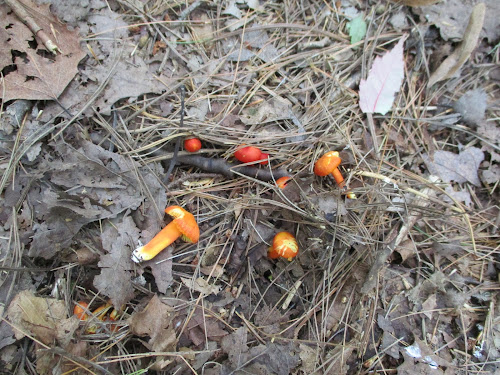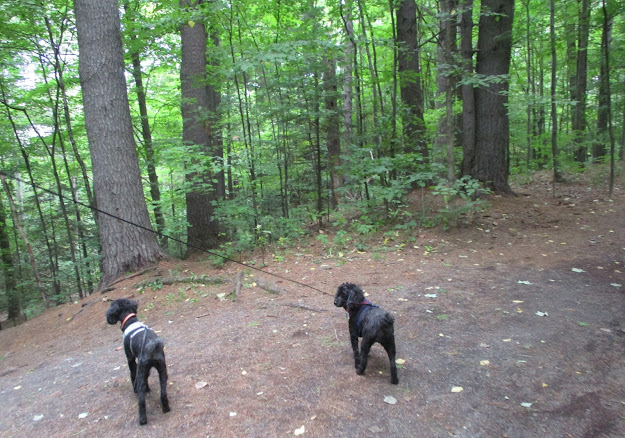There's no such thing as 'same old' in nature. Nothing is ever repeated as it was before. The continuous rounds of change, subtle and nuanced makes each day, each glimpse of a landscape, varied from how it affects us and how it appears from day to day. Nature has taught her creatures to carry on, to forge ahead, to grow and to mutate, to develop and to mature, to live and to die. In all the stops between unique characteristics emerge, some recognized, some not.
The fall asters now blooming in the ravine are confined for the present to the earliest ones, mostly white, while the others of variant sizes, presentations and colours hold themselves in abeyance, awaiting their turn. The time that elapses between the first appearance of the originals and the eventual appearance of the followers seems to take forever. The later-bloomers are infinitely more attractive, boast colours and symmetry the originals lack, and are are altogether more pleasant to look at.
The crop of mushrooms now emerging from the leaf mass of the forest floor, rich and fecund, are differentiated by shape, size and colour, along with texture and placement. Those that nature designed to grow directly on the trunks of ailing trees bear little resemblance to those meant to grow their underground filaments feeding on the wood fibre buried within the soil in tree roots and around the base of tree trunks.
Each has their assigned purpose and each cry out for notice for different reason, but all of them are unique; some long-lived and others casually dropping by for a day or two, symbols of the main body that spreads its presence underground. Many are edible, others are not. The Amanita muscaria that has dominated many areas of the forest lately, are edible with a caveat that they are poisonous unless the water-soluble toxins is leached from them.
They're also psychoactive causing hallucinations. So while they're exquisitely beautiful to behold, they're also problematical for anyone looking to harvest them for the table, or to take an acid trip from which they could conceivably suffer grievous harm. We're interested neither in nibbling nor flying, so we admire them and congratulate nature on her infinite store of surprises to be confronted on a leisurely stroll through her garden.
Jackie and Jillie aren't much interested in nibbling mushrooms. Though they're reputed by some sources to be of interest to some dogs. Dogs who could conceivably fall afoul of nature and become themselves seriously ill. On the other hand, when we were out in the ravine this morning, we did come across one of the mushrooms that had obviously been part of someone's breakfast. Toxins don't behave the same in all animals, so perhaps squirrels aren't affected by the poisonous aspect of this beautiful fungus.
It was a cold, albeit sunny morning, with plenty of wind, but quite unlike the warm wind of yesterday on a humid and mild day. No raincoats required today though, given the clear blue sky. A clear blue sky when we first set out on our morning's adventure. By the time we were halfway through the circuit, however that clear blue sky had changed to an aluminum-bright overcast. Presaging afternoon rain, which latterly always seems to develop in the afternoon, the evening, overnight. Little wonder the presence of so much fungi.
 |
| Yesterday's 'red berries' developed into tiny mushrooms |
Fungi filaments, by the way, are being predicted to become in food science, the next big wave of enterprise. Not only as a food source, but as material for the manufacture of clothing, and packaging. Decades and decades ago no one could believe that oil-derived products would come to dominate consumer markets in the manufacture of plastics -- all manner of oil-derived goods from car parts to panels for all manner of uses, and clothing -- either.
Remember the sage advice given Dustin Hoffman at the start of his acting career when he appeared as the naive and likeable schmuck in The Graduate? To invest in plastic, the next big thing.








No comments:
Post a Comment